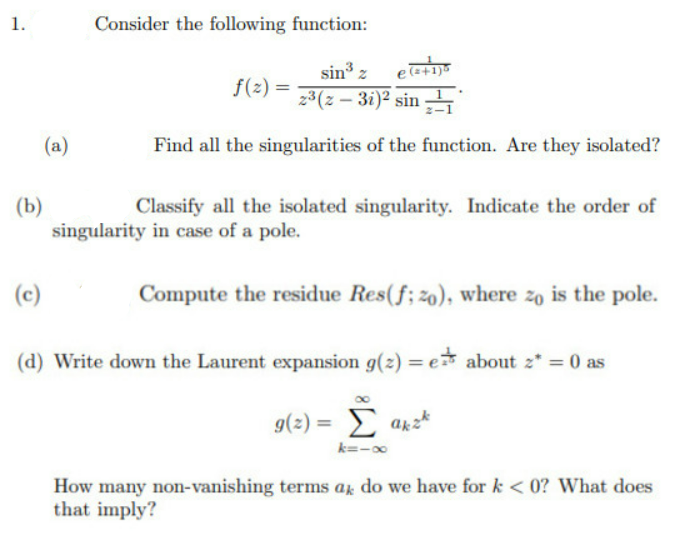sin z et f(z) = 23(z – 3i)² sin (a) Find all the singularities of the function. Are they isolated? (b) singularity in case of a pole. Classify all the isolated singularity. Indicate the order of
sin z et f(z) = 23(z – 3i)² sin (a) Find all the singularities of the function. Are they isolated? (b) singularity in case of a pole. Classify all the isolated singularity. Indicate the order of
Linear Algebra: A Modern Introduction
4th Edition
ISBN:9781285463247
Author:David Poole
Publisher:David Poole
Chapter7: Distance And Approximation
Section7.2: Norms And Distance Functions
Problem 41EQ
Related questions
Question
[Complex Variables] How do you solve the first question? Thanks
![Laurent* Series
We know that a function that is analytic in the disc |z –- zol < R may be expanded
there in a power series and that, conversely, if a function has a power series valid in
the disc |z – zol < R, it is analytic in this disc. But what about a function f that is
analytic only in the punctured disc 0 < |z – zol < R or, even worse, analytic only
in the annulus 0<r < ]z – zol< R? We shall show here that something almost as
good as a power series can be given to represent f(z), r < |z – zol < R. Namely, we
shall show that
f(2) = f1(2) + f2(2),
r < |z – zol < R,
* Pierre Alphonse Laurent, 1813-1854.
142
Chapter 2 Basic Properties of Analytic Functions
where f, is analytic on the disc |z – zol < R and f2 is analytic on the region
r< Iz – zol, including at o. f, has a power series in the variable z – z, which is
valid for |z – zol < R, while f, has a power series in the variable (z – zo)-1 which
is valid for r < |z – zol (see Exercise 23, Section 4). Consequently,
f(z) = E a(z – zo)* + E ba(z – 20)-*,
k=0
k=1
or
f(2) = E a(z – zo)*,
a-k = br,
k = 1, 2, ...,
r < |z – zol < R.
k=-00](/v2/_next/image?url=https%3A%2F%2Fcontent.bartleby.com%2Fqna-images%2Fquestion%2Fa9a68973-aba6-43e3-ad2d-a07edcd07678%2F1bb43d63-293a-4d4c-880e-dec7df49bdfd%2Ffo3he6j_processed.png&w=3840&q=75)
Transcribed Image Text:Laurent* Series
We know that a function that is analytic in the disc |z –- zol < R may be expanded
there in a power series and that, conversely, if a function has a power series valid in
the disc |z – zol < R, it is analytic in this disc. But what about a function f that is
analytic only in the punctured disc 0 < |z – zol < R or, even worse, analytic only
in the annulus 0<r < ]z – zol< R? We shall show here that something almost as
good as a power series can be given to represent f(z), r < |z – zol < R. Namely, we
shall show that
f(2) = f1(2) + f2(2),
r < |z – zol < R,
* Pierre Alphonse Laurent, 1813-1854.
142
Chapter 2 Basic Properties of Analytic Functions
where f, is analytic on the disc |z – zol < R and f2 is analytic on the region
r< Iz – zol, including at o. f, has a power series in the variable z – z, which is
valid for |z – zol < R, while f, has a power series in the variable (z – zo)-1 which
is valid for r < |z – zol (see Exercise 23, Section 4). Consequently,
f(z) = E a(z – zo)* + E ba(z – 20)-*,
k=0
k=1
or
f(2) = E a(z – zo)*,
a-k = br,
k = 1, 2, ...,
r < |z – zol < R.
k=-00

Transcribed Image Text:1.
Consider the following function:
sin3
23(z- 3i)2 sin
f(z) =
(a)
Find all the singularities of the function. Are they isolated?
(b)
singularity in case of a pole.
Classify all the isolated singularity. Indicate the order of
(c)
Compute the residue Res(f; zo), where zo is the pole.
(d) Write down the Laurent expansion g(z) = e about z* = 0 as
g(2) = arz*
k=-0
How many non-vanishing terms a do we have for k < 0? What does
that imply?
Expert Solution
This question has been solved!
Explore an expertly crafted, step-by-step solution for a thorough understanding of key concepts.
Step by step
Solved in 2 steps with 1 images

Recommended textbooks for you

Linear Algebra: A Modern Introduction
Algebra
ISBN:
9781285463247
Author:
David Poole
Publisher:
Cengage Learning

Algebra & Trigonometry with Analytic Geometry
Algebra
ISBN:
9781133382119
Author:
Swokowski
Publisher:
Cengage

Linear Algebra: A Modern Introduction
Algebra
ISBN:
9781285463247
Author:
David Poole
Publisher:
Cengage Learning

Algebra & Trigonometry with Analytic Geometry
Algebra
ISBN:
9781133382119
Author:
Swokowski
Publisher:
Cengage